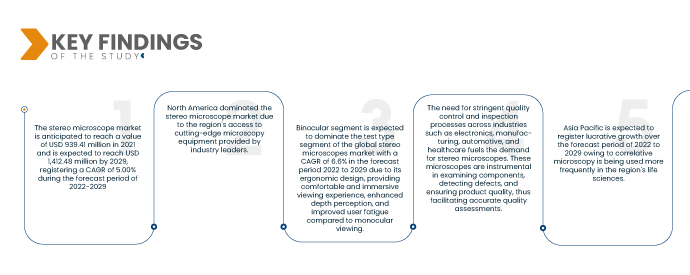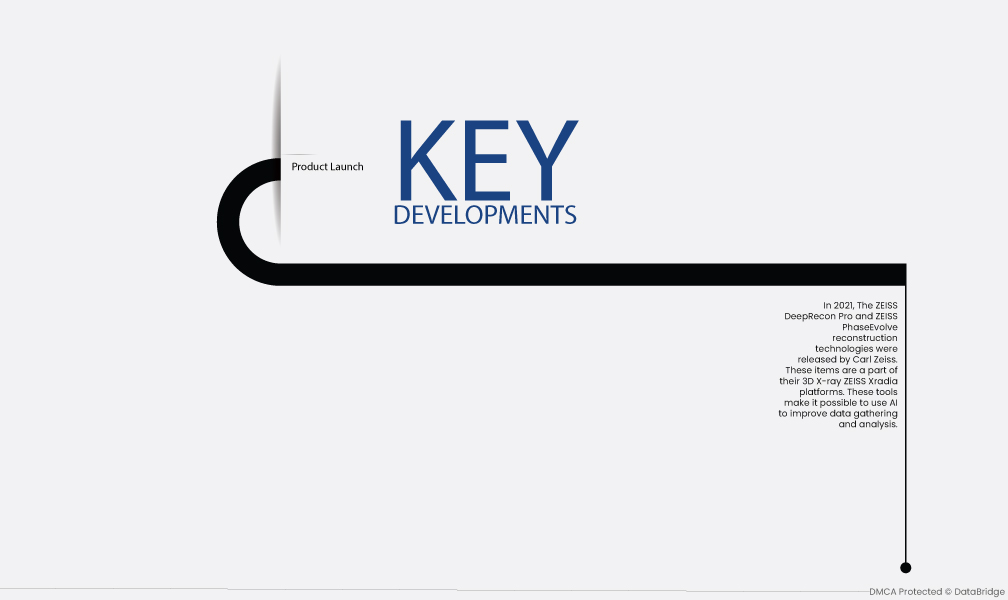The stereo microscope market is experiencing positive growth and adoption globally. Stereo microscopes offer enhanced visualization, magnification, and depth perception, enabling precise observations and analysis. They find applications in scientific research, education, healthcare, and industrial sectors. The market benefits from advancements in technology, such as digital imaging integration, which enhances functionality and usability. Additionally, the market's expansion is fueled by the increasing demand for quality control and inspection processes across industries. Overall, the stereo microscope market provides valuable tools for detailed examination and analysis in various fields.
Access Full Report at https://www.databridgemarketresearch.com/ru/reports/global-stereo-microscope-market
Data Bridge Market Research analyses that the Global Stereo Microscope Market is expected to grow at a value of USD 939.41 million in 2021 and is expected to reach USD 1,412.48 million by 2029, registering a CAGR of 5.00% during the forecast period of 2022-2029. The continuous advancements in scientific research, particularly in fields such as biology, chemistry, and materials science, drive the demand for stereo microscopes. These microscopes offer enhanced visualization and magnification capabilities, enabling researchers to study intricate details and make precise observations.
Key Findings of the Study
Growing demand in emerging economies is expected to drive the market's growth rate
Emerging economies are witnessing a growing demand for stereo microscopes due to increased industrialization and investment in research and development. These countries are expanding their healthcare infrastructure and educational institutions, leading to a need for advanced microscopy solutions. This creates opportunities for market growth as businesses and institutions seek precise visualization and magnification capabilities for scientific research, diagnostics, quality control, and educational purposes in these rapidly developing regions.
Report Scope and Market Segmentation
|
Report Metric
|
Details
|
|
Forecast Period
|
2022 to 2029
|
|
Base Year
|
2021
|
|
Historic Years
|
2020 (Customizable to 2014 - 2019)
|
|
Quantitative Units
|
Revenue in USD Million, Volumes in Units, Pricing in USD
|
|
Segments Covered
|
Test Type (Monocular, Binocular, Trinocular), Design Type (Greenough Type, Parallel Optics Type), Zooming Type (Motorized Zoom, Manual Zoom), Application (Industrial, Life Science), End User (Clinical and Laboratories, Research Institutes, Industrial Inspection and Academics)
|
|
Countries Covered
|
U.S., Canada and Mexico in North America, Germany, France, U.K., Netherlands, Switzerland, Belgium, Russia, Italy, Spain, Turkey, Rest of Europe in Europe, China, Japan, India, South Korea, Singapore, Malaysia, Australia, Thailand, Indonesia, Philippines, Rest of Asia-Pacific (APAC) in the Asia-Pacific (APAC), Saudi Arabia, U.A.E, South Africa, Egypt, Israel, Rest of Middle East and Africa (MEA) as a part of Middle East and Africa (MEA), Brazil, Argentina and Rest of South America as part of South America.
|
|
Market Players Covered
|
Nikon Corporation (Japan), Cole-Parmer Instrument Company, LLC. (U.S.), Unitron (U.S.), Vision Engineering Ltd. (U.K.), KEYENCE CORPORATION (Japan), ZEISS International (Germany), Meiji Techno (U.S.), Scienscope International Inc. (U.S.), Thermo Fisher Scientific Inc. (U.S.), Seiwa Optical America Inc. (U.S.), KERN & SOHN GmbH (Germany), Celestron, LLC. (U.S.), Boeckel + Co (Gmbh + Co) (Germany), A.KRÜSS Optronic GmbH (Germany), Walter Products (India), Olympus Corporation (Japan), Aven Tools (U.S.), Leica Microsystems (Germany), Guilin Maite Optical Instrument Co., Ltd. (China), among others
|
|
Data Points Covered in the Report
|
In addition to the insights on market scenarios such as market value, growth rate, segmentation, geographical coverage, and major players, the market reports curated by the Data Bridge Market Research also include depth expert analysis, patient epidemiology, pipeline analysis, pricing analysis, and regulatory framework.
|
Segment Analysis:
The stereo microscope market is segmented on the basis of test type, design type, zooming type, application, and end user
- On the basis of test type, the stereo microscope market is segmented into monocular, binocular, and trinocular. The binocular segment is expected to dominate the test type segment of the global stereo microscopes market with a CAGR of 6.6% in the forecast period 2022 to 2029 due to its ergonomic design, providing comfortable and immersive viewing experience, enhanced depth perception, and improved user fatigue compared to monocular viewing.
- On the basis of design type, the stereo microscope market is segmented into Greenough type, parallel optics type. The greenough type segment is expected to dominate the design type segment of the global stereo microscopes market with a CAGR of 6.6% in the forecast period 2022 to 2029 due to its superior optical performance, increased depth perception, and improved image quality. It offers precise and detailed observations, making it a preferred choice for various applications.
In 2022, the greenough type segment is expected to dominate the design type segment of the global stereo microscopes market
In 2022, the greenough type segment is expected to dominate the design type segment of the global stereo microscopes market owing to its enhanced depth perception, superior optical performance, and higher image quality. It is a popular choice for many applications because it provides accurate and thorough observations with a CAGR of 6.6% in the forecast period 2022 to 2029.
- On the basis of zooming type, the stereo microscope market is segmented into motorized zoom, manual zoom. The motorized zoom segment is expected to dominate the zooming type segment of the global stereo microscopes market with a CAGR of 7.3% in the forecast period 2022 to 2029 due to its convenience and versatility. It allows users to easily adjust the magnification level using motorized controls, providing precise and efficient zooming capabilities for various applications and observation requirements.
- On the basis of application, the stereo microscope market is segmented into industrial, and life science. The life science segment is expected to dominate the application segment of the global stereo microscopes market with a CAGR of 7.0% in the forecast period 2022 to 2029 due to its widespread application in biological research, medication, and medical testing. Stereo microscopes make it possible to examine objects, cellular structures, and biological processes in great detail, advancing the study of life sciences.
In 2022, the Life science segment is expected to dominate the application segment of the global stereo microscopes market
In 2022, the life science segment is expected to dominate the application segment of the global stereo microscopes market owing to its extensive use in biological research, pharmaceuticals, and medical diagnostics. Stereo microscopes enable detailed examination of specimens, cellular structures, and biological processes, supporting advancements in life science fields with a CAGR of 7.0% in the forecast period 2022 to 2029.
- On the basis of end user, the stereo microscope market is segmented into clinical and laboratories, research institutes, industrial inspection and academics. Industrial inspection segment is expected to dominate end user segment of the global stereo microscopes market with a CAGR of 6.1% in the forecast period 2022 to 2029 due to its critical role in quality control, defect detection, and precision measurements in manufacturing and industrial processes. Stereo microscopes provide accurate and detailed visualization for efficient inspection and analysis.
Major Players
Data Bridge Market Research recognizes the following companies as the major stereo microscope market players in stereo microscope market are Cole-Parmer Instrument Company, LLC. (U.S.), Unitron (U.S.), Vision Engineering Ltd. (U.K.), KEYENCE, ZEISS International (Germany), Meiji Techno (U.S.), Nikon Corporation (Japan), KERN & SOHN GmbH (Germany), Celestron, LLC. (U.S.), Boeckel + Co (Gmbh + Co) (Germany)
Market Development
- In 2021, The ZEISS DeepRecon Pro and ZEISS PhaseEvolve reconstruction technologies were released by Carl Zeiss. These items are a part of their 3D X-ray ZEISS Xradia platforms. These tools make it possible to use AI to improve data gathering and analysis.
Regional Analysis
Geographically, the countries covered in the stereo microscope market report are U.S., Canada and Mexico in North America, Germany, France, U.K., Netherlands, Switzerland, Belgium, Russia, Italy, Spain, Turkey, Rest of Europe in Europe, China, Japan, India, South Korea, Singapore, Malaysia, Australia, Thailand, Indonesia, Philippines, Rest of Asia-Pacific (APAC) in the Asia-Pacific (APAC), Saudi Arabia, U.A.E, South Africa, Egypt, Israel, Rest of Middle East and Africa (MEA) as a part of Middle East and Africa (MEA), Brazil, Argentina and Rest of South America as part of South America.
As per Data Bridge Market Research analysis:
North America is the dominant region in the stereo microscope market during the forecast period 2022 to 2029
North America's dominance in the stereo microscope market can be attributed to multiple factors. The region benefits from the presence of leading market players who offer advanced microscopy systems with cutting-edge technologies. This availability of high-quality and innovative products gives North America a competitive edge. Additionally, North America boasts a strong research and development ecosystem, robust healthcare infrastructure, and a thriving industrial sector that drives the demand for stereo microscopes. The region's emphasis on technological advancements and investment in scientific research further contribute to its dominance in the market.
Asia-Pacific is estimated to be the fastest growing region in the stereo microscope market for the forecast period 2022 to 2029
Asia-Pacific (APAC) is anticipated to experience substantial growth in the stereo microscope market from 2022 to 2029, primarily driven by the rising adoption of correlative microscopy in life sciences. Correlative microscopy combines multiple imaging techniques to provide comprehensive insights into biological specimens. The region's growing focus on life sciences research, advancements in healthcare infrastructure, and increasing investment in scientific studies contribute to the increased application of correlative microscopy in APAC. This trend fuels the demand for stereo microscopes, positioning the region for significant market growth in the forecast period.
For more detailed information about the stereo microscope market report, click here – https://www.databridgemarketresearch.com/ru/reports/global-stereo-microscope-market














